Mango Jam Recipe Without Pectin
This post may contain affiliate links, view our disclosure policy for details.
This Mango jam recipe without pectin is easy to make and is delicious! It’s also made with less sugar so it’s not overly sweet and I’ll show you how to preserve this jam for months.
You guys, I didn’t know that you can make jam from mangos! I’ve never seen it, not even in specialty food stores and I’ve never met anyone who made it. And I had never tasted it before… I was doing my regular grocery shopping at Walmart in town a few weeks ago, and as I strolled the veggie/fruit area I was wondering what kind of jam to make to sell at the farmer’s market.
I was looking for a sale on something when I spotted the mangos… They were on sale for 66 cents a pound. In my book, any fruit that is under a dollar a pound is great. 66 cents a pound is well under a dollar and is a great price for mangos in our area. And then I was thinking… Can I make mango jam?
Easy Mango Jam Recipe Without Peectin…
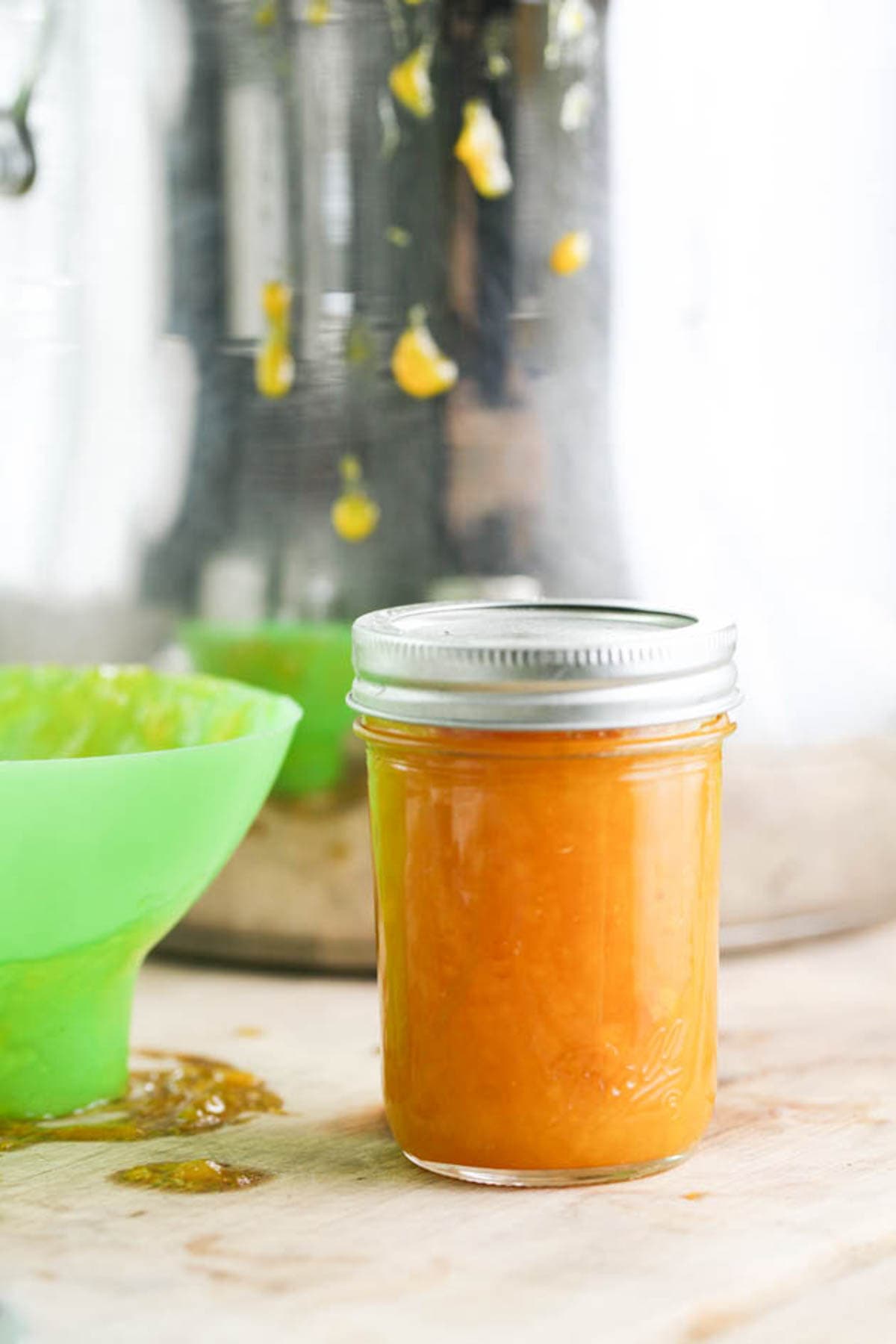
I figured, why not? I was kinda already on a roll with never-heard-off-before jams with the cantaloupe jam and the kiwi jam and persimmon jam that I made a few weeks earlier so I was more than willing to try my hand at mango jam.
I got home and did some online research. I found this mango jam and a few more but I ended up deciding to just follow my own jam-making process and see if it will work well with mangos. Oh boy… I was not ready for the level of deliciousness that I created!
Mango jam is right up there now with my favorite fig jam and mulberry jam for sure! And it wasn’t just me! The jars of mango jam ended up selling better than my low sugar strawberry jam at the farmer’s market. You guys, I think we have a winner!
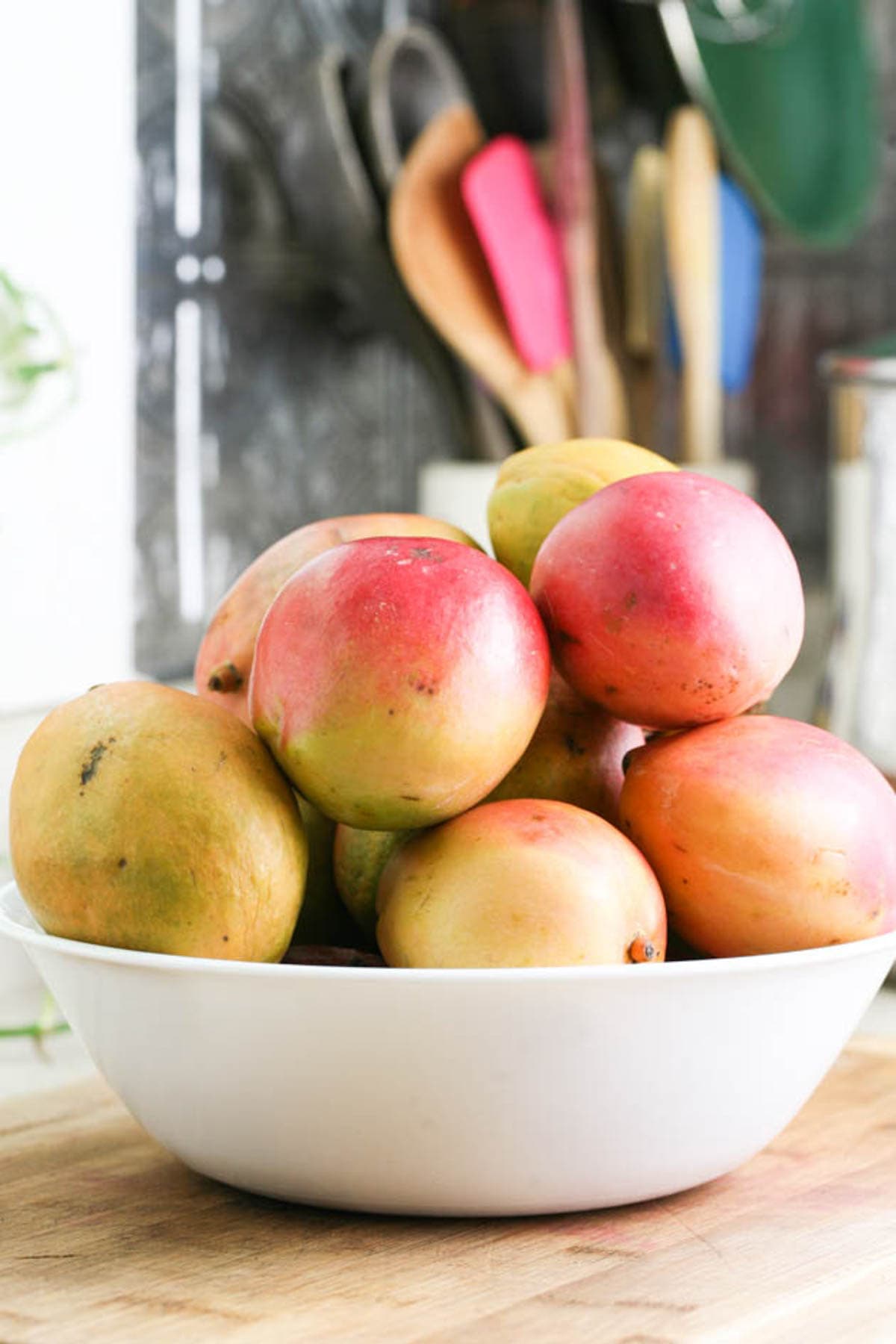
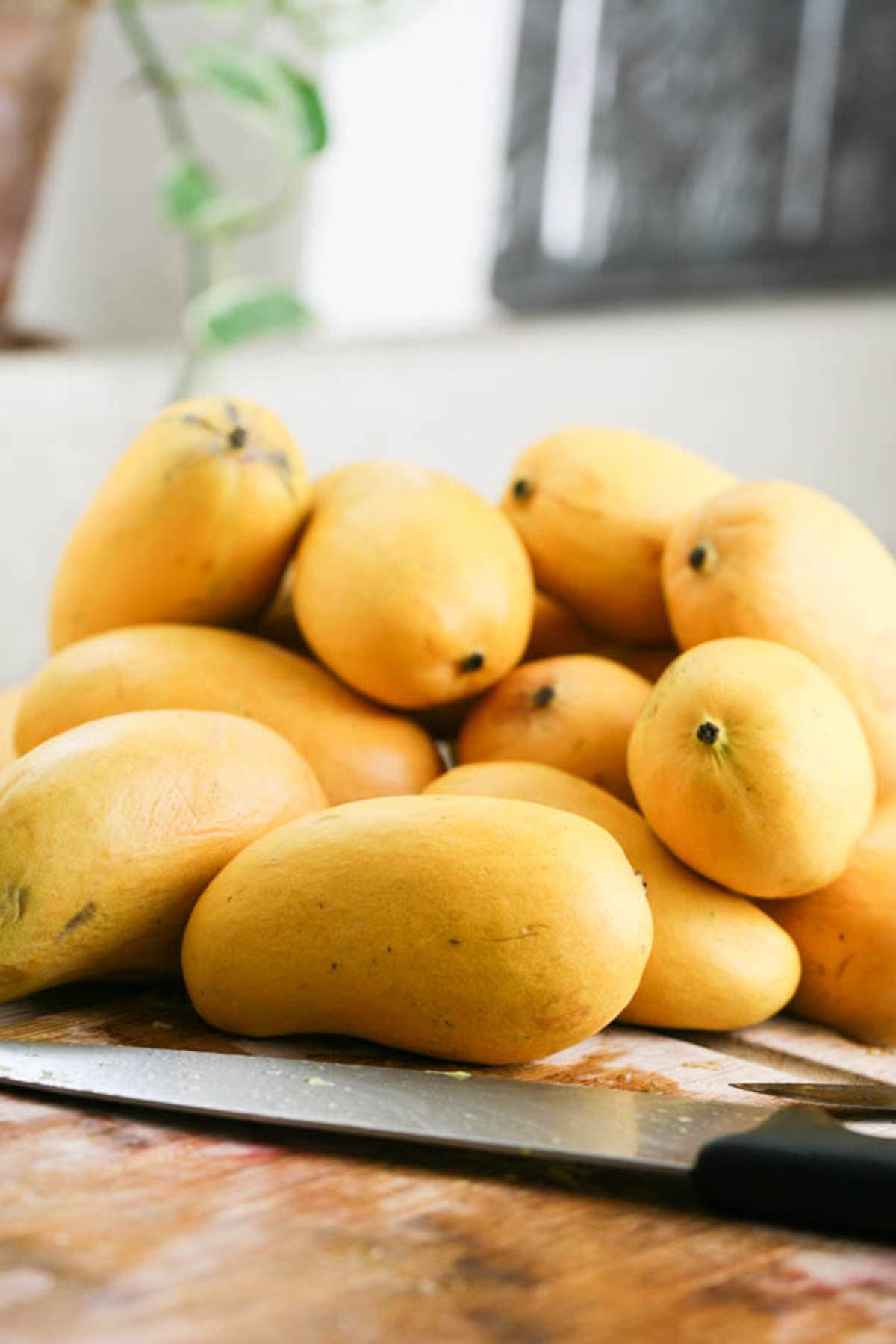
Ingredients…
- Mangos – the variety of mango that you use does not matter. There are many varieties of mangos and they are all delicious. You can even mix a couple or a few varieties easily, just make sure that the fruit is ripe. Above, on the left, are either Glen or Carrie mangos that probably came from Florida. On the right are Lemon Meringue mangos that came from either the Bahamas or Florida (I’m guessing). I have to admit that the Lemon Meringue mangos are my favorite. Thier flash is bright orange and they are very sweet.
Please note… I usually don’t recommend processing more than 4 pounds of fruit at a time since it’s getting a bit tricky to reach gel phase with more than 4 pounds of fruit. However, I got carried away a bit with buying all those delicious mangos (37 of them…) so I ended up processing 9 pounds of fruit here (and ended up with 23 half-pint jars). It worked surprisingly well with mangos, however, if you don’t want to process such a large batch it’s very simple to adjust this recipe. I’ll walk you thorugh how to do it in the FAQ section below. - Sugar – no matter how much fruit you are using, use half of the wieght of the fruit in sugar. Here I used 4.5 pounds of sugar. Traditionally, you’d use a ratio of one part fruit to one part sugar when making jams, however this is way to sweet for us so I cut the sugar in half. The jam is still planty sweet enough and can be preserved for months.
- Lemon juice – from one medium lemon.
- Lemon seeds – I added 6-7 seeds. Since we aren’t using store-bought pectin we’ll use lemon seeds instead. They have natural pectin in them and will help us thicken the jam without changing its taste.
Kitchen Tools…
- Cutting board
- Peeler
- Knife
- Large bowl
- Large pot
- Spoon
- Immersion blender
- Water bath canner
- Ladle
- 1/2 pint jars
- Lids and bands
- Canning utensils
- Paper towel
How to Make Mango Jam Without Pectin…
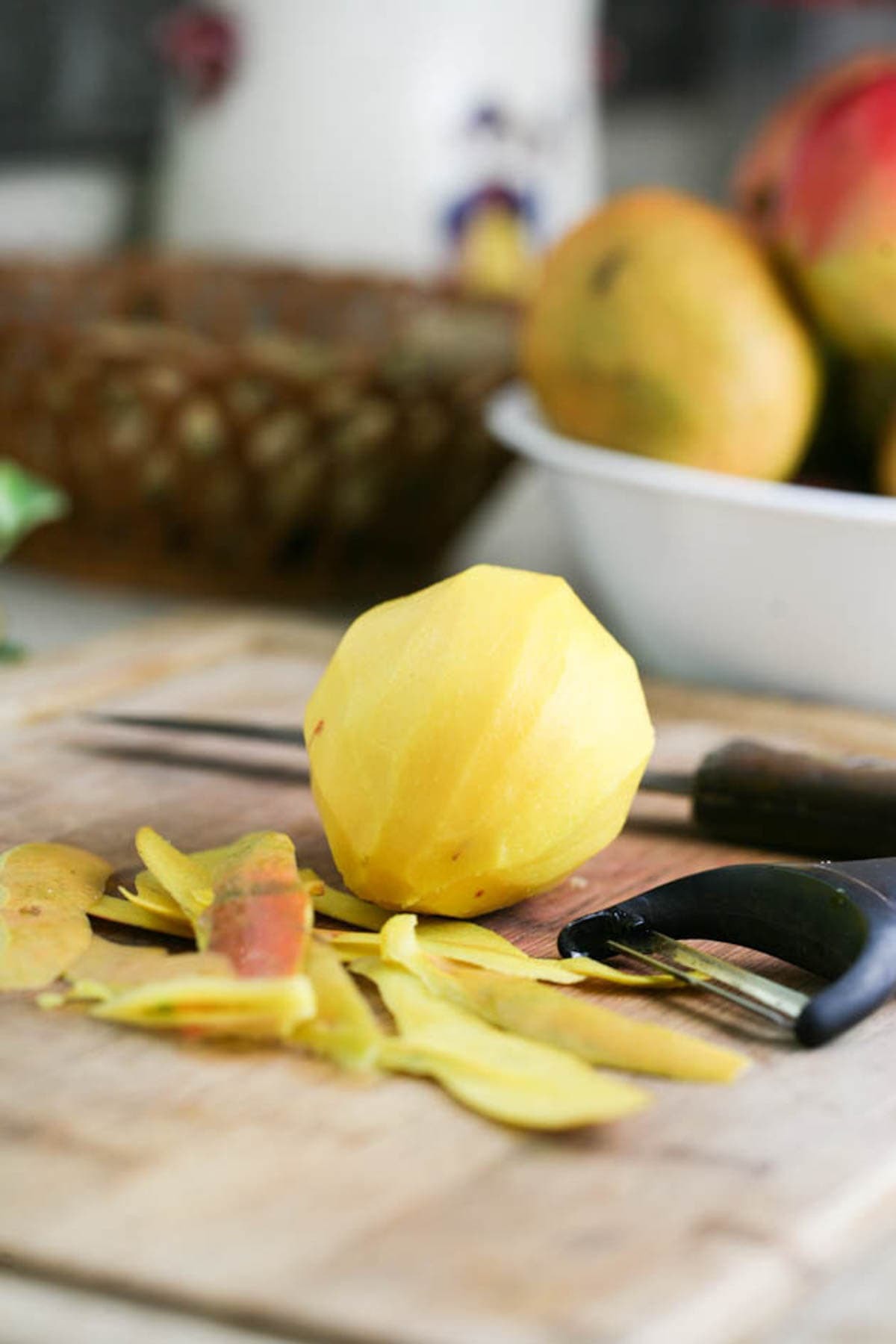
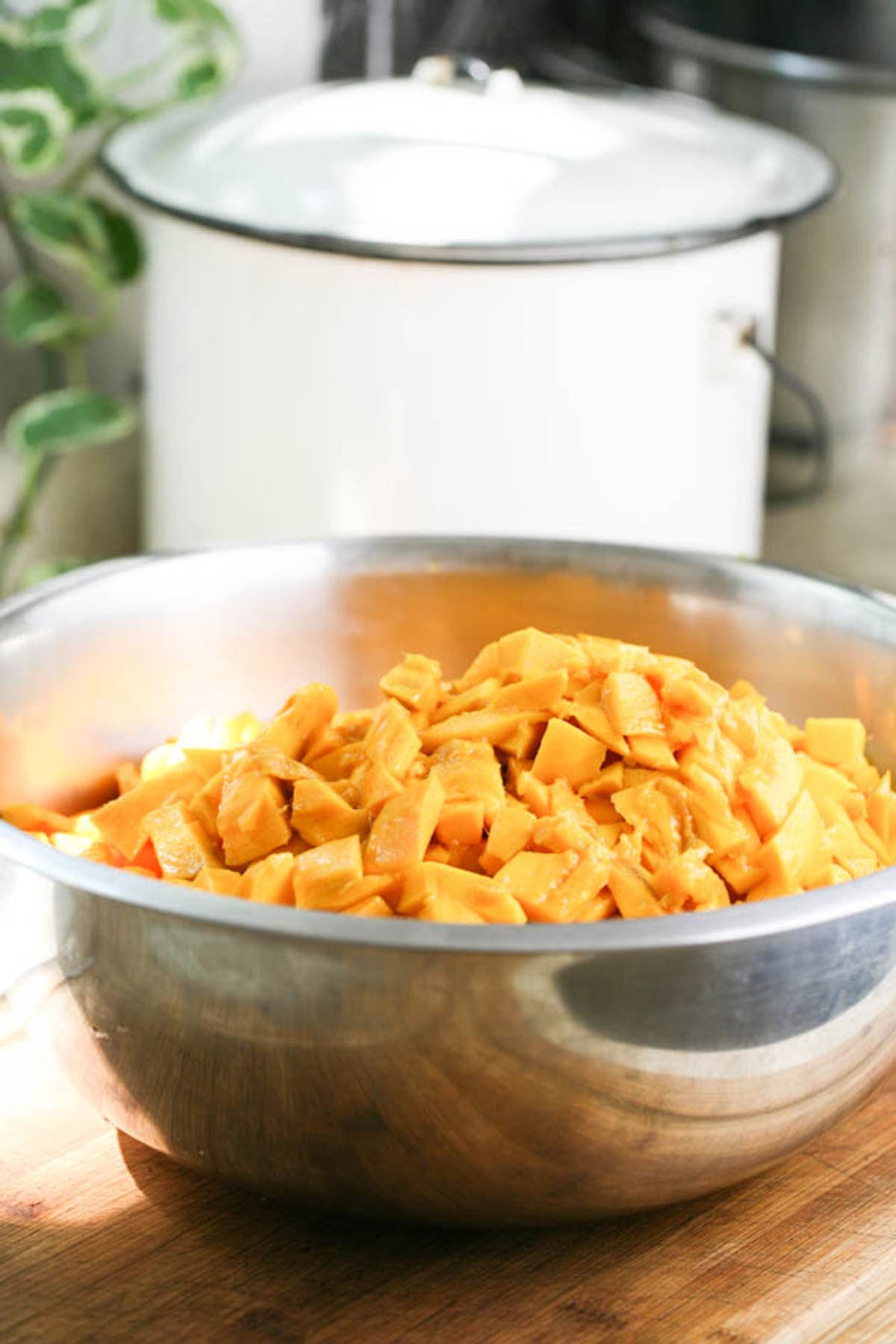
Step one – prep the mangos. Start by peeling the mangos (I use a vegetable peeler), cut around the pit, and dice the mango flash.
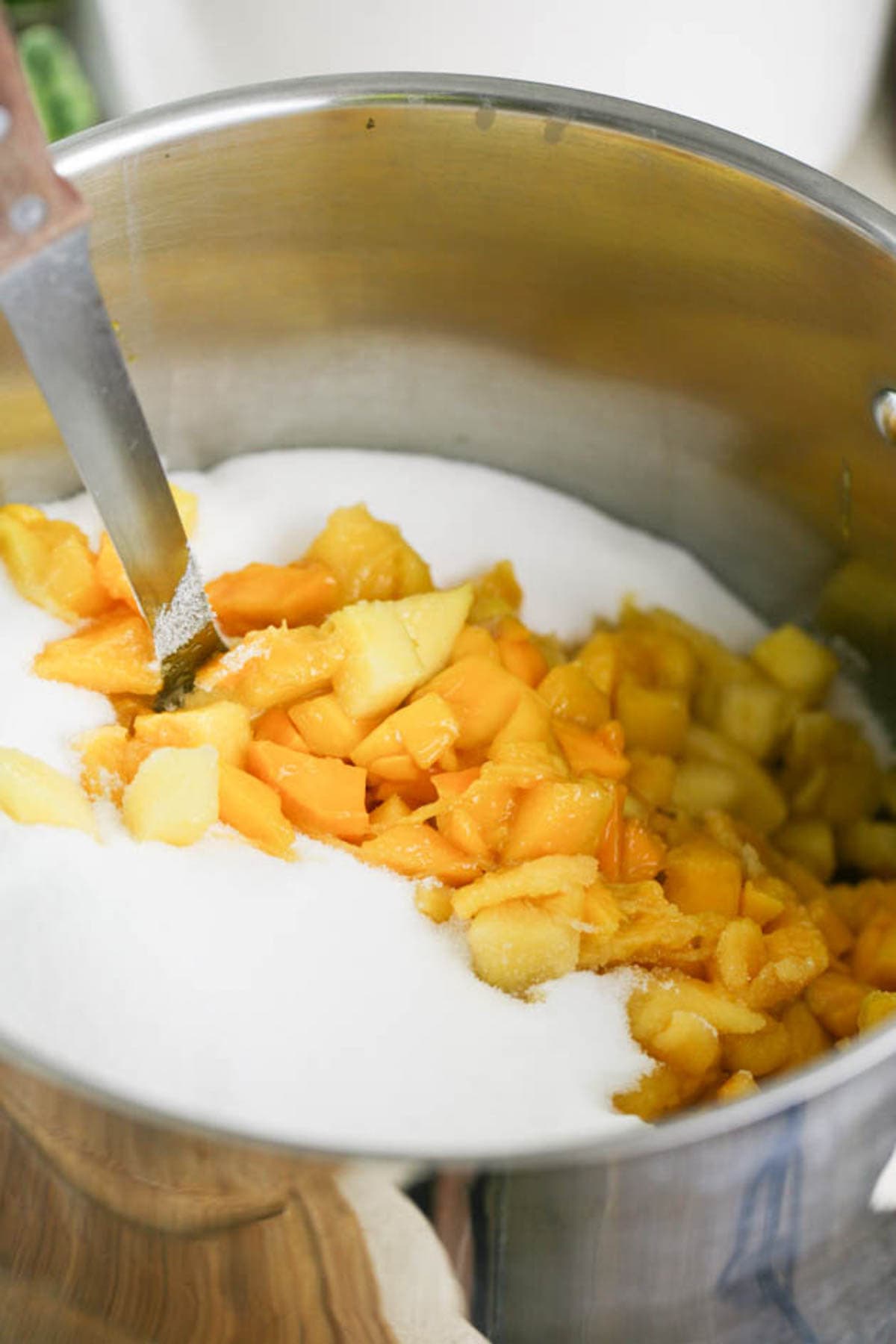
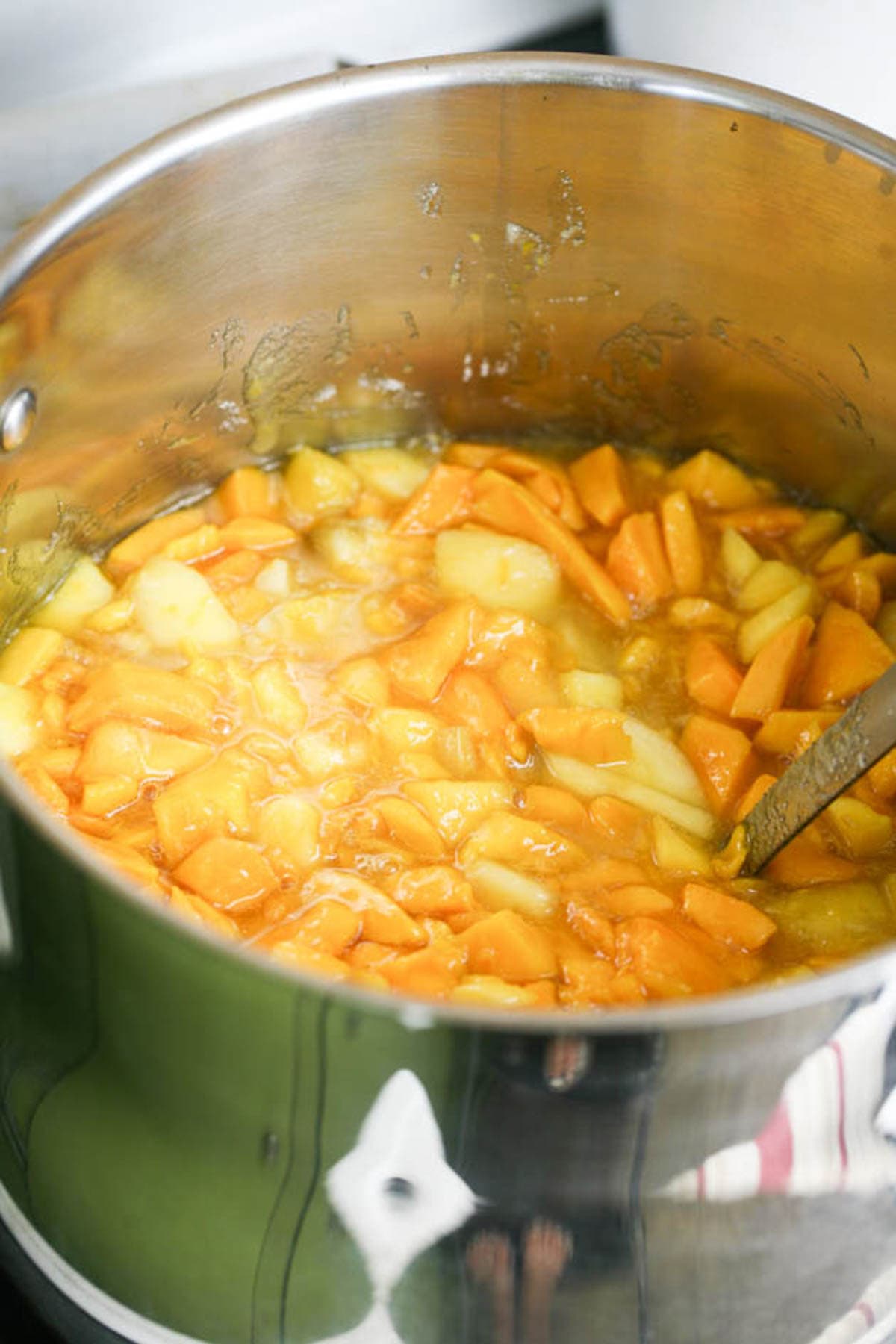
Step two – bring to a boil. Add the fruit and sugar to a pot or a deep pan (if you are processing less fruit), set on the stovetop, turn the heat to medium-high and bring to a boil, stirring frequently. Boil for 10 minutes, then lower the heat to medium-low and keep cooking for an additional 15 minutes.

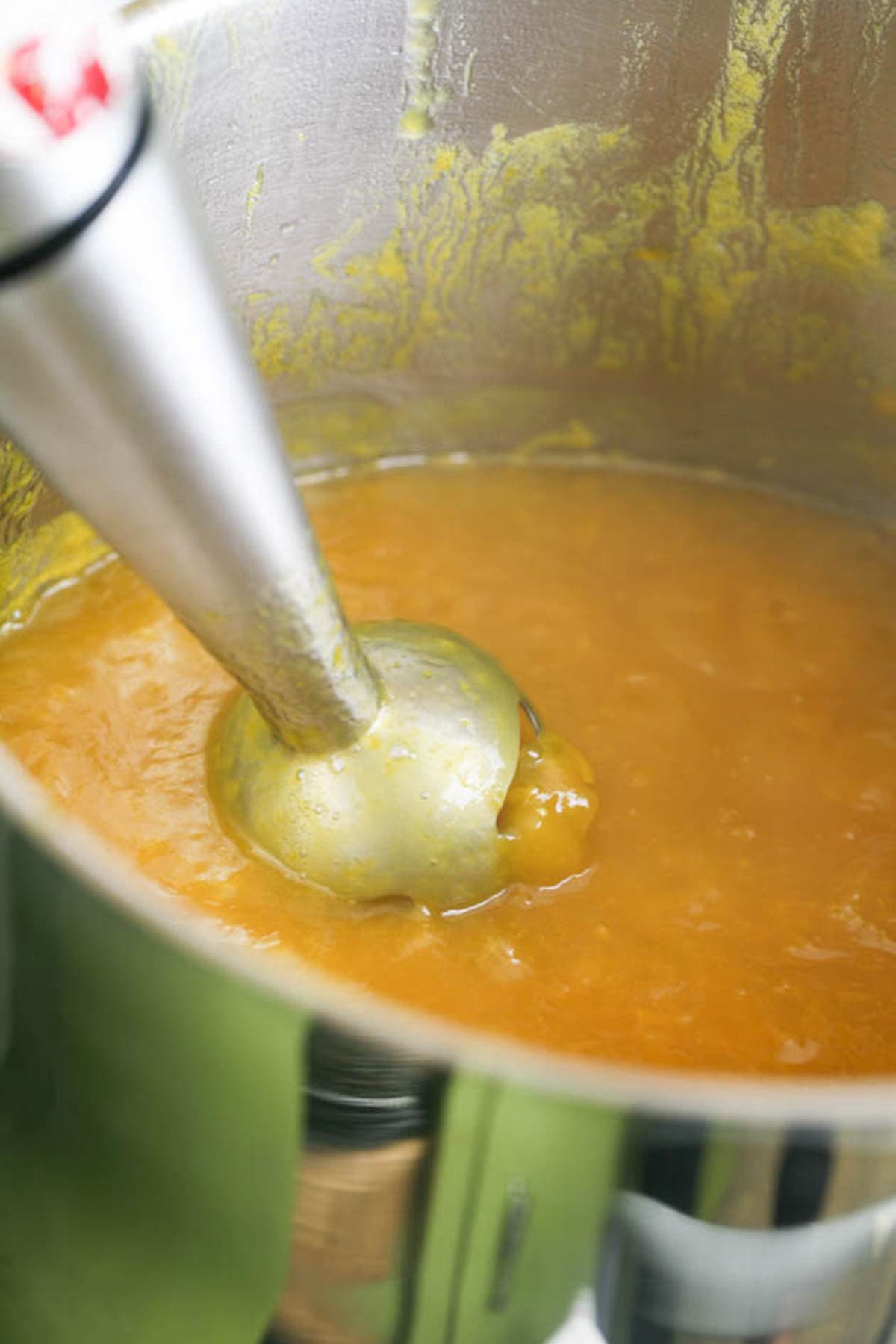
Step three – blend and fish foam. Mangos hold their shape surprisingly well during cooking. I use an immersion blender to blend the fruit and smooth the jam. If you like chunks of fruit in your jam you can use a potato masher instead. Also, mango jam creates quite a lot of foam so use a spoon to fish some or most of it out.
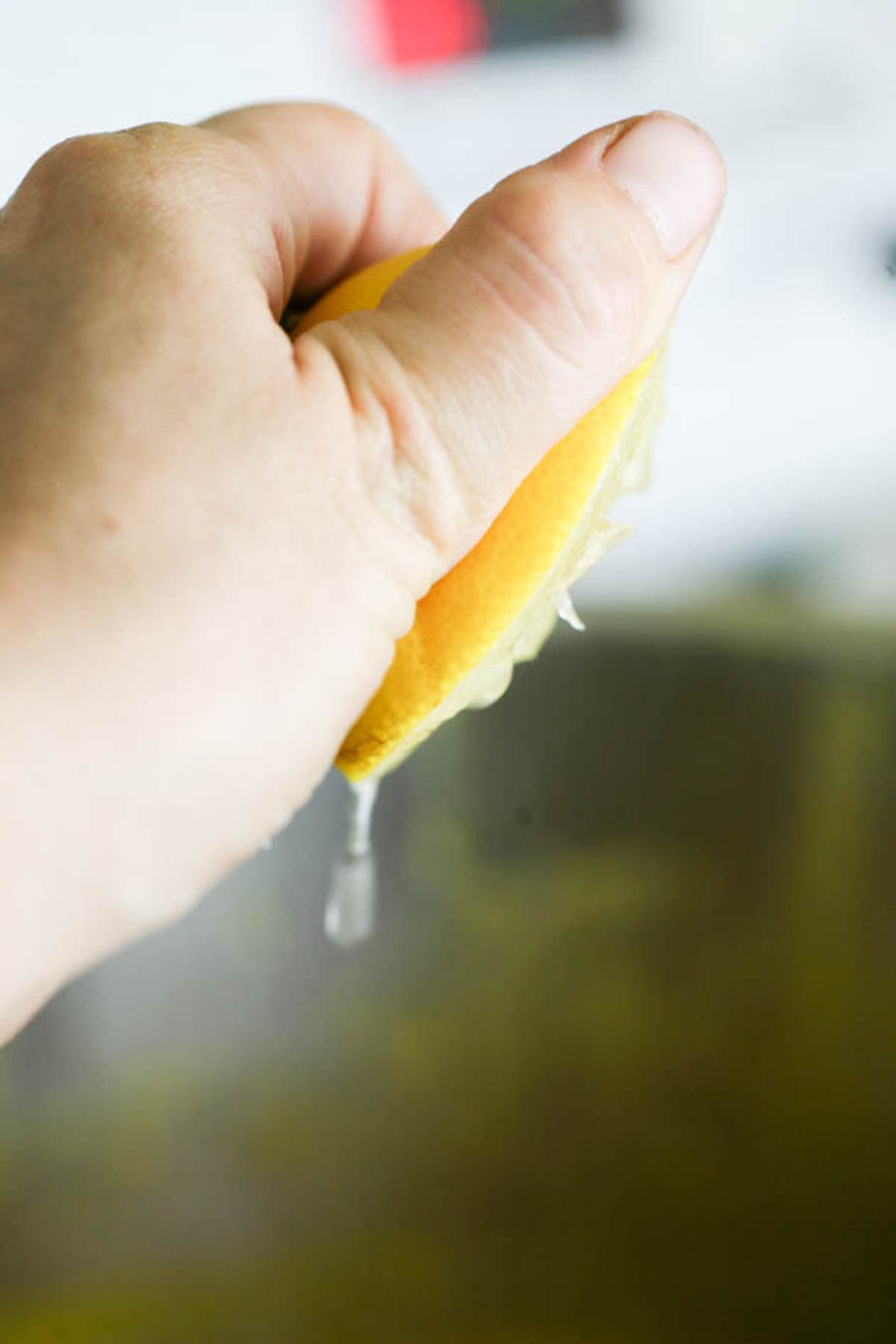
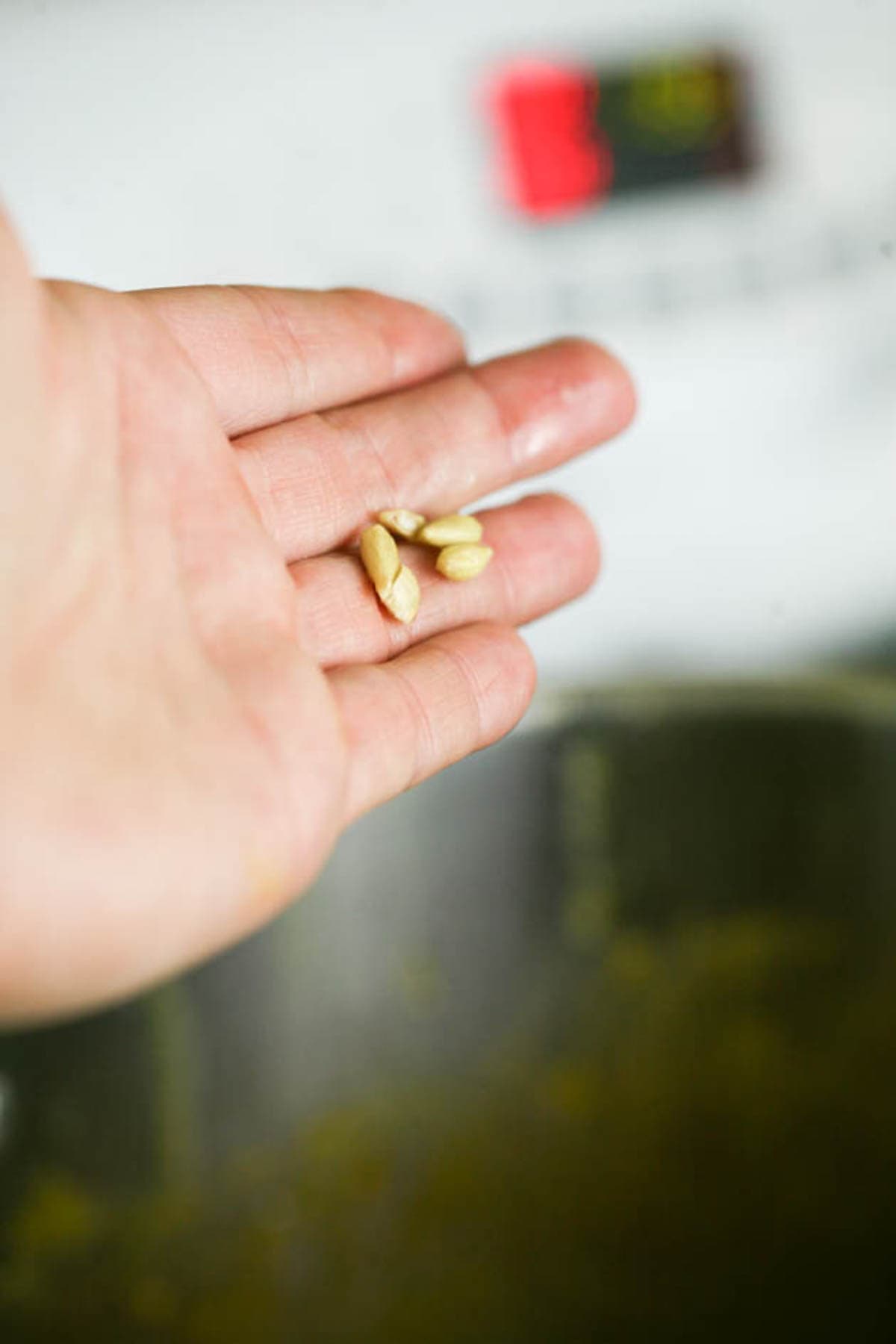
Step four – add lemon juice and seeds. Let the jam cook for five more minutes after blending and then add the lemon juice and lemon seeds. Stir them in and cook for ten more minutes.
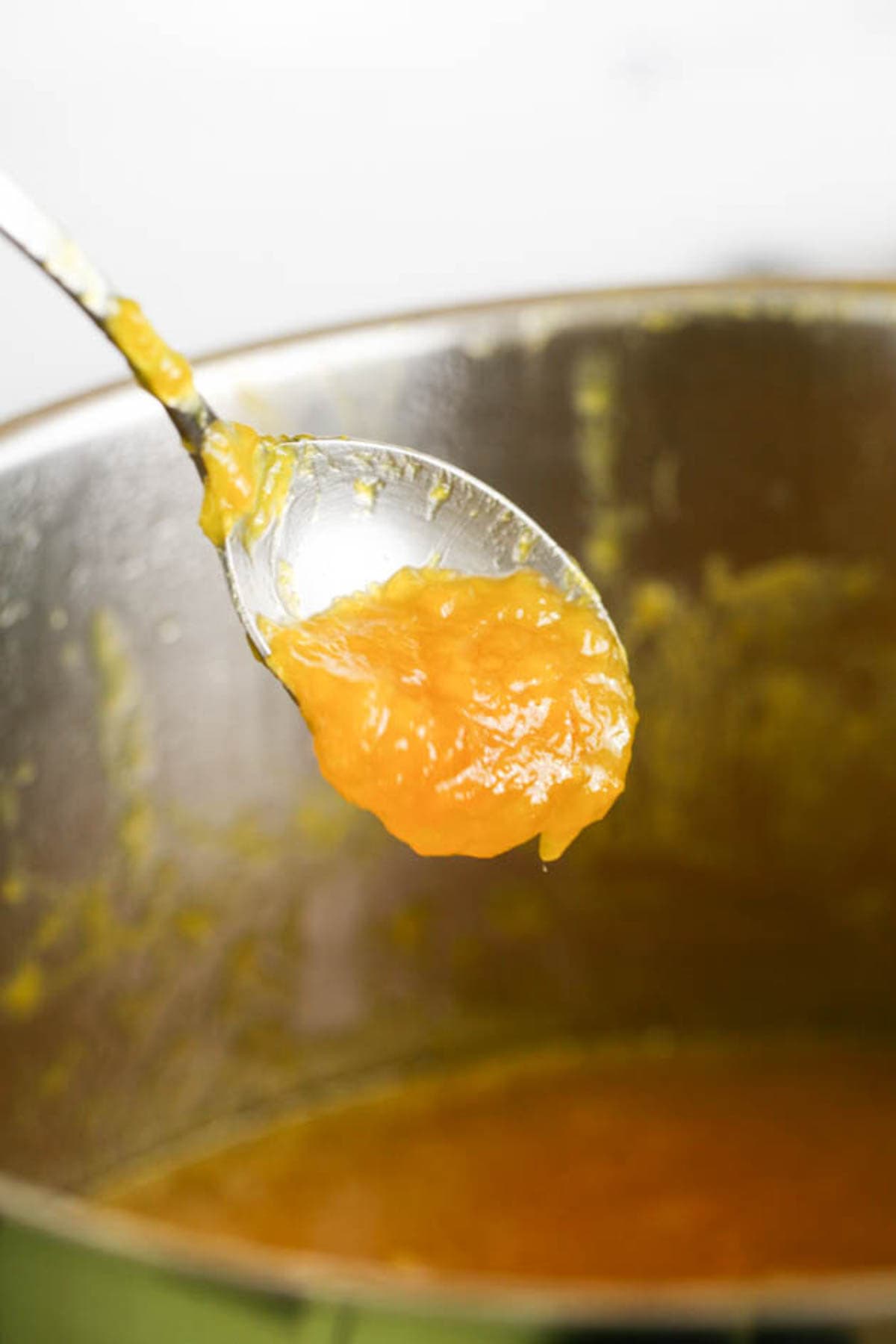
Step five – check if your jam is ready. Scoop some jam on a spoon and set the spoon on the counter to cool for five minutes. Then add the jam back into the pot and as it leaves the spoon you’ll be able to measure how thick it is and when it’s done. Just take into consideration that the jam will thicken a little more in the jars as it cools after canning.
If you processed a small amount of fruit, you can simply turn the heat off, let the jam cool a bit, add it to jars and keep in the fridge. It should last months in the fridge. If you want to can your jam so you can keep it at room temperature read on…
Canning Homemade Mango Jam…
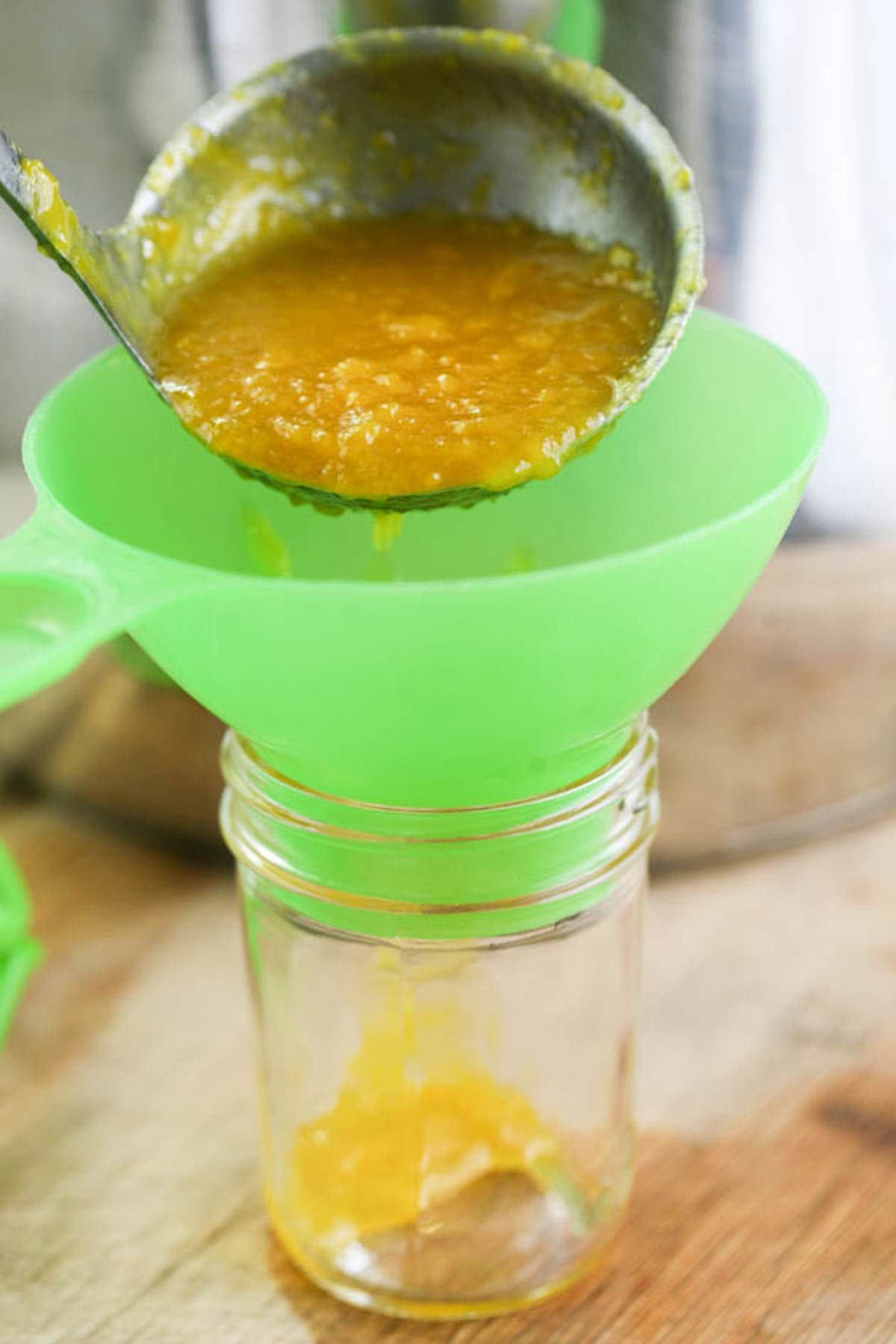
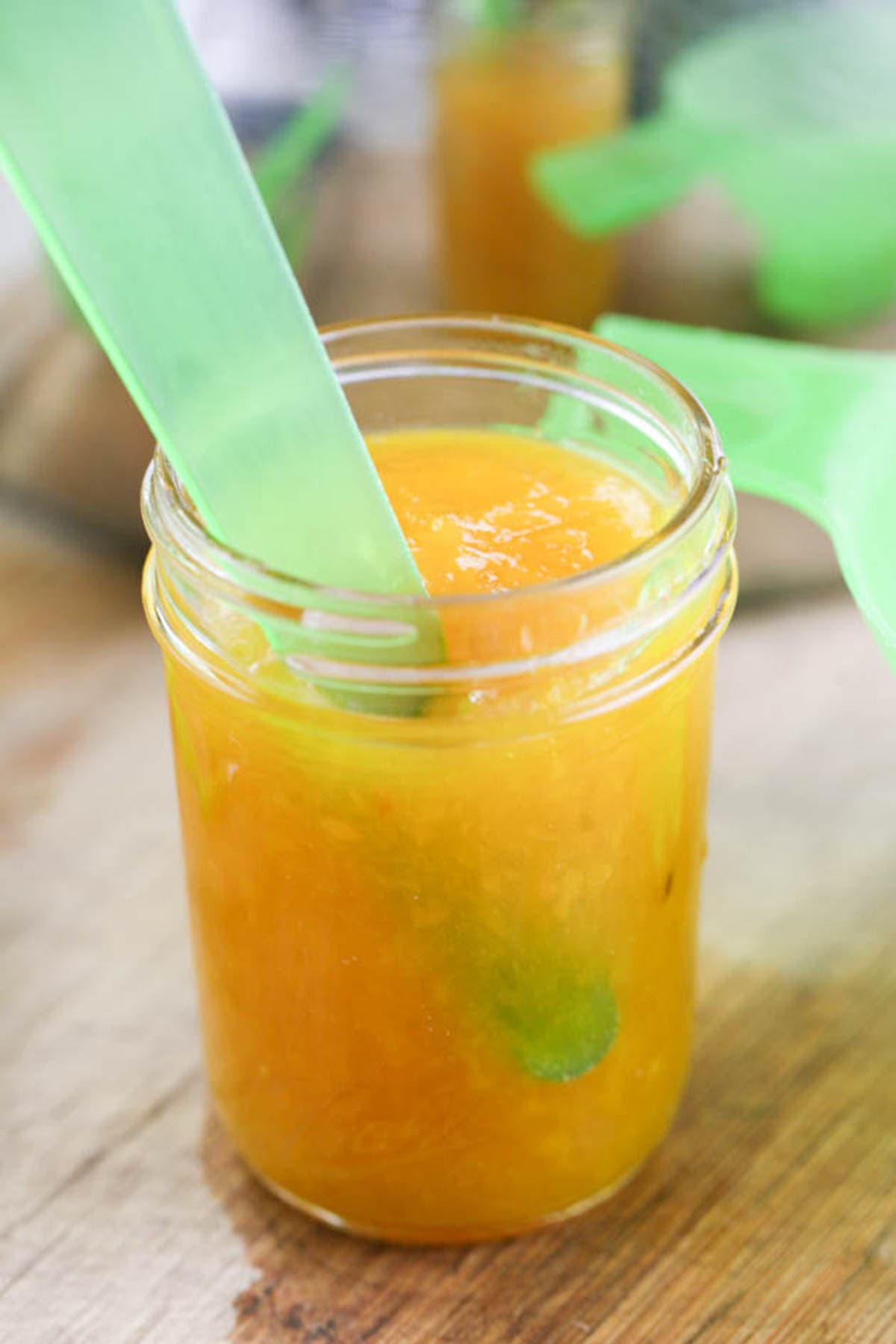
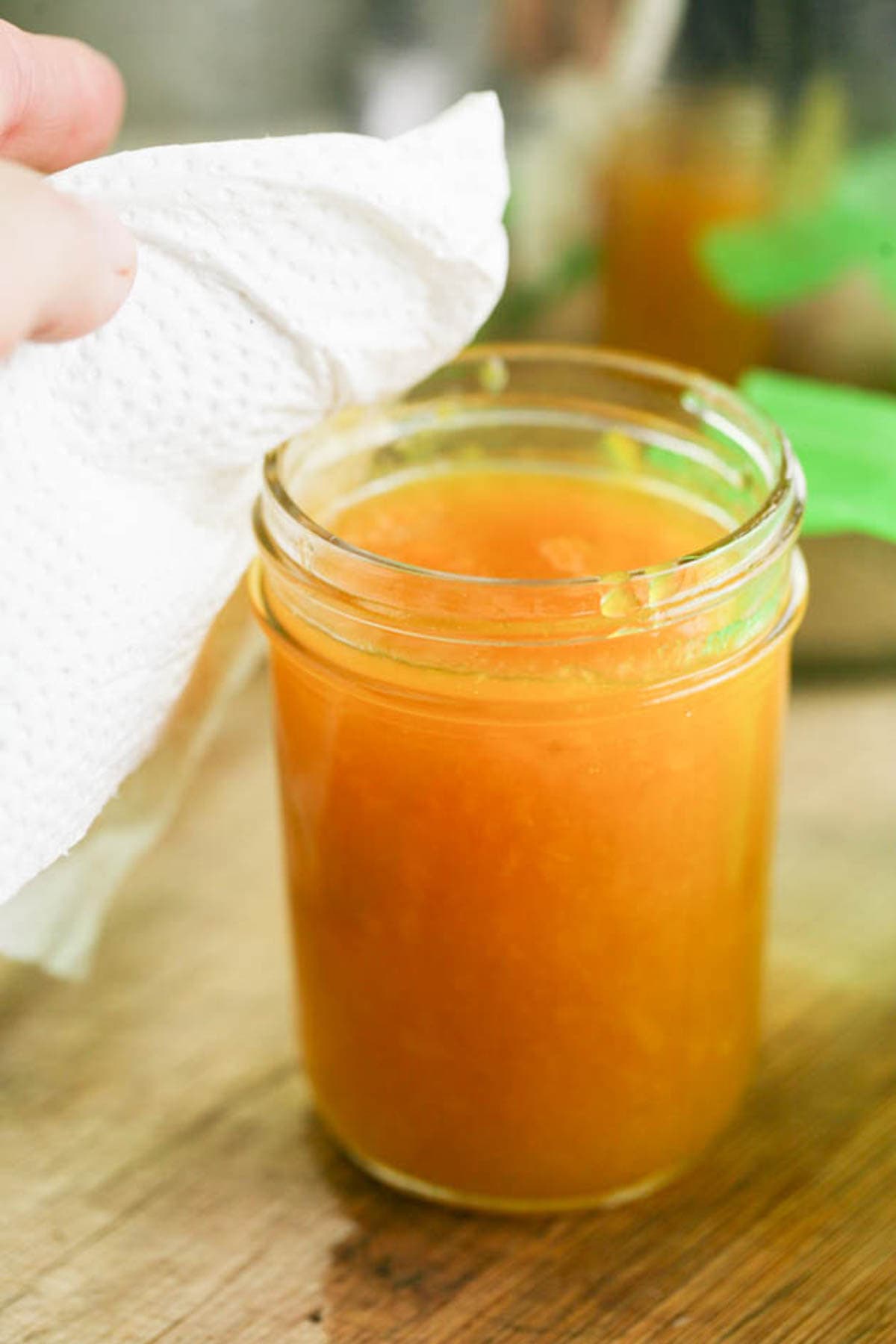

Step six – prep for canning. Fill your water bath canner with enough water to cover the jars by about an inch. Set it on the stovetop, turn the heat to high and bring the water to a boil. Wash the jars, lids, and bands well with hot water and soap.
Fill the jars with the hot jam, making sure to leave 1/2 inch of headspace. Use the bubble remover to remove air bubbles by scraping it along the inside of the jars. Use a damp paper towel to clean the rim of the jar, then center the lid and close the jar with the band fingertight.
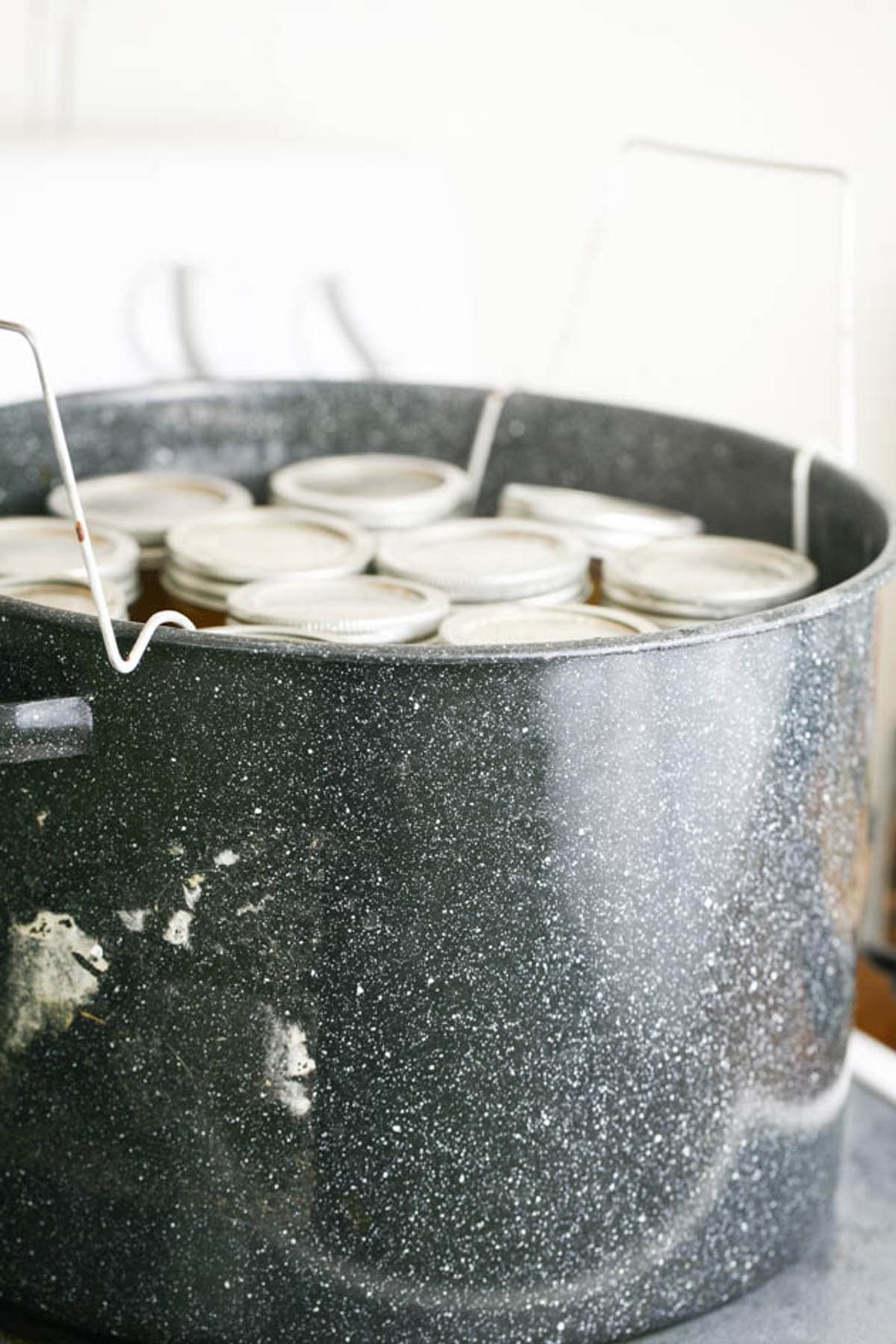
Step seven – process the jars. Set the filled jars on the rack of the water bath canner and lower the rack into the boiling water. Cover the canner and process the jars for ten minutes (pint and half-pint jars). If you live above 1000 feet in elevation, adjust the processing time according to the table below.
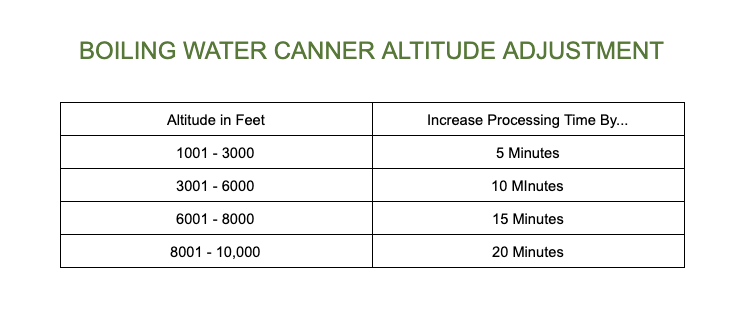
Once processing time is over, use the jar lifters to remove the jars from the boiling water and set them on a kitchen towel on the kitchen counter to cool completely overnight.
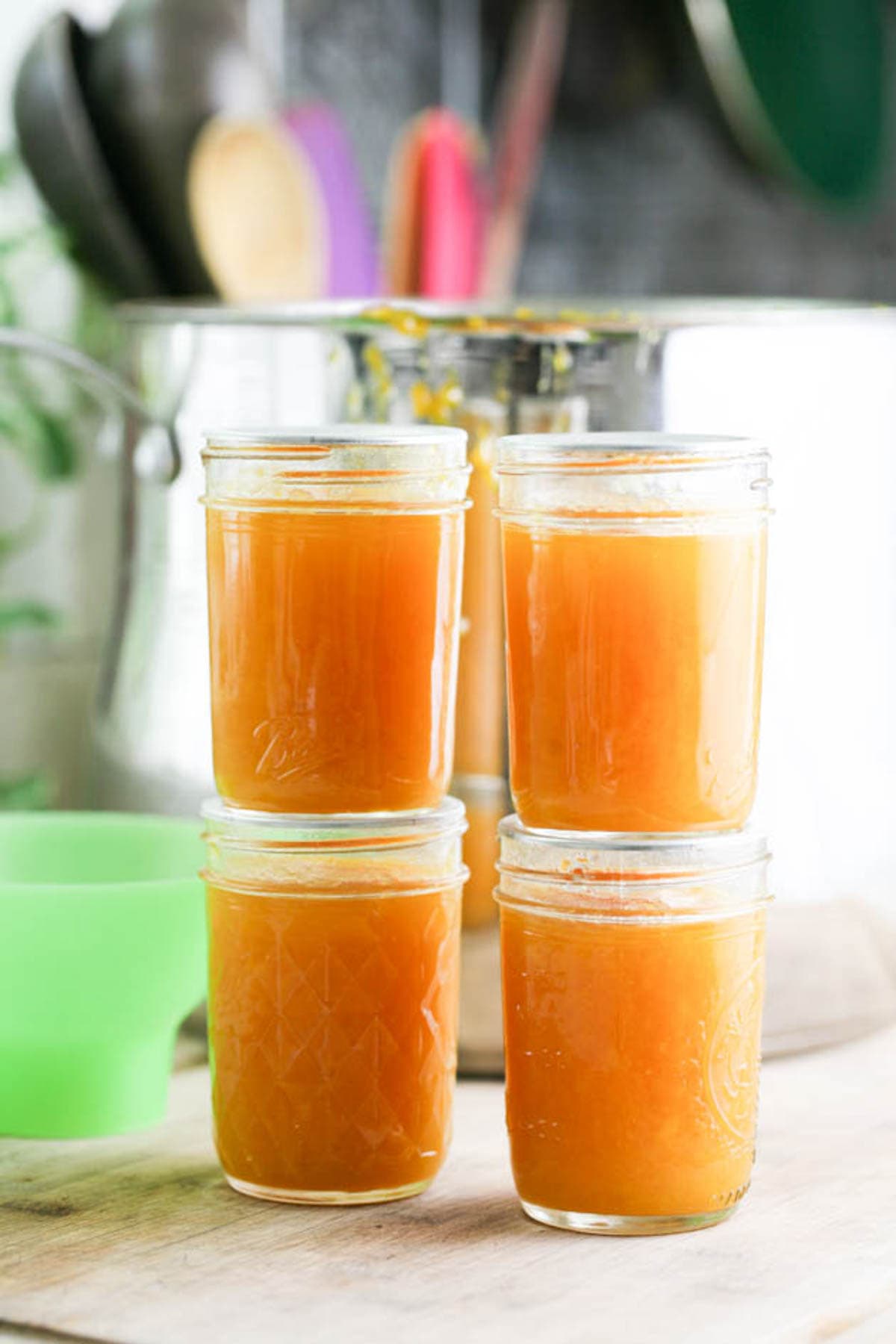
Storing Canned Homemade Mango Jam…
Once the jars have cooled completely check to see if they are all sealed by pressing the center of the lid. If there is no movement there this means that the jars are sealed and ready for storage. If you have a jar that didn’t seal, you can keep it in the fridge and use it first or you can try to process it again.
I like storing my jars without the bands since they tend to rust and make it hard to open the jar months later. So remove the bands and wipe your jars before placing them in the pantry. Mango jam should last for up to 18 months on the shelf.
How to Serve Mango Jam…
- As a snack – we love spreading cream cheese on crackers (or a bagel) and adding some jam on top. It’s an awesome mid day snack for the whole family.
- On a toast – I always drink coffee in the morning and a toast with some jam on it is the perfect companion.
- In cookies – I make these thumbprint cookies and add jam in the center. They melt in your mouth and are absolutely addictive!
- On yogurt – homemade yogurt (made with either raw milk or store-bought) with homemade granola and a tablespoon or so of jam is my go-to meal when I have no energy to cook a “real” one.
- Add it to baked goods – if it’s a jam danish, a turnover, jam filled bars, this simple jam tart (my personal favorite!), or any other baked good, this jam will work great!
Freqentley Asked Questions…
Yes, and it’s very easy. Just follow a ratio of one part fruit to one-half part sugar. So if you have 2 pounds of fruit, use one pound of sugar. The only thing that is going to change is the cooking time. And if you make a smaller batch, you can simply keep it in the fridge, it should last for weeks.
Yes. You can season this jam with nutmeg, or vanilla extract (or anything else you want to try but those work well). Add about a teaspoon 10 minutes before the jam is ready. If you are using vanilla extract, add it when the jam is ready.
I don’t. I leave the seeds in the jam. They don’t break down, don’t change the taste of the jam no matter how long it stays on the shelf and once you stop cooking the jam they don’t keep thickening it. You can, however, fish them out when the jam is ready if you’d like, they are usually easy to find.
I was very surprised at how easy it was to make mango jam. We love mangos and this is just another delicious way to consume them and preserve them. I hope that you’d give it a try!
More Jam Recipes…
- Peach Jam Recipe
- Chia Blueberry Jam Recipe
- How to Make Candied Oranges
- Sugar Free Strawberry jam
- And for a list of all of the jam recipes that I have here on the blog, make sure to check my jam recipe page.

Mango Jam Recipe Without Pectin
This is a large batch of delicious low sugar mango jam with no store-bought pectin. It's very easy to make a smaller batch. Check the notes for more information.
Ingredients
- 37 mangos (9 lb of diced mangos. Check notes if you want to process less fruit)
- 4.5 lb of sugar
- Juice of one medium lemon
- 6-7 lemon seeds
Instructions
- Step one - Start by peeling the mangos (I use a vegetable peeler), cut around the pit, and dice the mango flash.
- Step two - Add the fruit and sugar to a pot or a deep pan (if you are processing less fruit), set on the stovetop, turn the heat to medium-high and bring to a boil, stirring frequently. Let boil for 10 minutes, then lower the heat to medium-low and keep cooking for an additional 15 minutes.
- Step three - Use an immersion blender to blend the fruit and smooth the jam. If you like chunks of fruit in your jam you can use a potato masher instead. Also, mango jam creates quite a bit of foam so use a spoon to fish some or most of it out.
- Step four - Let the jam cook for five more minutes after blending and then add the lemon juice and lemon seeds. Stir them in and cook for ten more minutes.
- Step five - Scoop some jam on a spoon and set the spoon on the counter to cool for five minutes. Then add the jam back into the pot and as it leaves the spoon you’ll be able to measure how thick it is and when it’s done. Just take into consideration that the jam will thicken a little more in the jars as it cools after canning.
If you processed a small amount of fruit, you can simply turn the heat off, let the jam cool a bit, add it to jars and keep it in the fridge. It should last months in the fridge. If you want to can your jam so you can keep it at room temperature read on… - Step six - Fill your water bath canner with enough water to cover the jars by about an inch. Set it on the stovetop, turn the heat to high and bring the water to a boil. Wash the jars, lids, and bands well with hot water and soap.
Fill the jars with the hot jam, making sure to leave 1/2 inch of headspace. Use the bubble remover to remove air bubbles by scraping it along the inside of the jars. Use a damp paper towel to clean the rim of the jar, then center the lid and close the jar with the band fingertight. - Step seven - Set the filled jars on the rack of the water bath canner and lower the rack into the boiling water. Cover the canner and process the jars for ten minutes (pint and half-pint jars). If you live above 1000 feet in elevation, adjust the processing time according to the table in the notes below.
Once processing time is over, use the jar lifters to remove the jars from the boiling water and set them on a kitchen towel on the kitchen counter to cool completely overnight. - Step eight - Once the jars have cooled completely check to see if they are all sealed by pressing the center of the lid. If there is no movement there this means that the jars are sealed and ready for storage. If you have a jar that didn’t seal, you can keep it in the fridge and use it first or you can try to process it again.
I like storing my jars without the bands since they tend to rust and make it hard to open the jar months later. So remove the bands and wipe your jars before placing them in the pantry. Mango jam should last for up to 18 months on the shelf.
Notes
If you live above 1000 in elevation, make sure to adjust processing time according to the table below...

Frequently Asked Questions...
- Can I adjust the quantities of the ingredients?
Yes, and it’s very easy. Just follow a ratio of one part fruit to one-half part sugar. So if you have 2 pounds of fruit, use one pound of sugar. The only thing that is going to change is the cooking time. And if you make a smaller batch, you can simply keep it in the fridge, it should last for weeks. - Can I add spices to this jam?
Yes. You can season this jam with nutmeg, or vanilla extract (or anything else you want to try but those work well). Add about a teaspoon 10 minutes before the jam is ready. If you are using vanilla extract, add it when the jam is ready. - Do you remove the lemon seeds before canning the jam?
I don’t. I leave the seeds in the jam. They don’t break down, don’t change the taste of the jam no matter how long it stays on the shelf and once you stop cooking the jam they don’t keep thickening it. You can, however, fish them out when the jam is ready if you’d like, they are usually easy to find.
Nutrition Information:
Yield: 368 Serving Size: 1 tablespoonAmount Per Serving: Calories: 43Total Fat: 0gSaturated Fat: 0gTrans Fat: 0gUnsaturated Fat: 0gCholesterol: 0mgSodium: 1mgCarbohydrates: 11gFiber: 1gSugar: 10gProtein: 0g



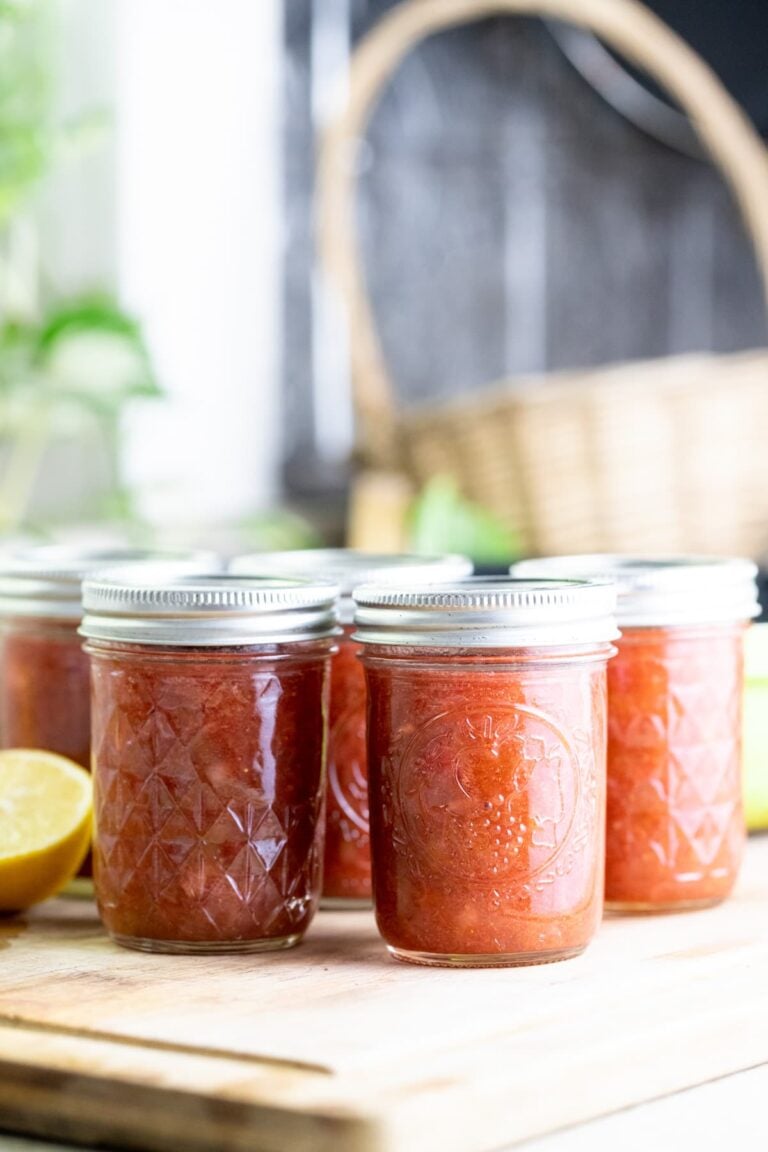
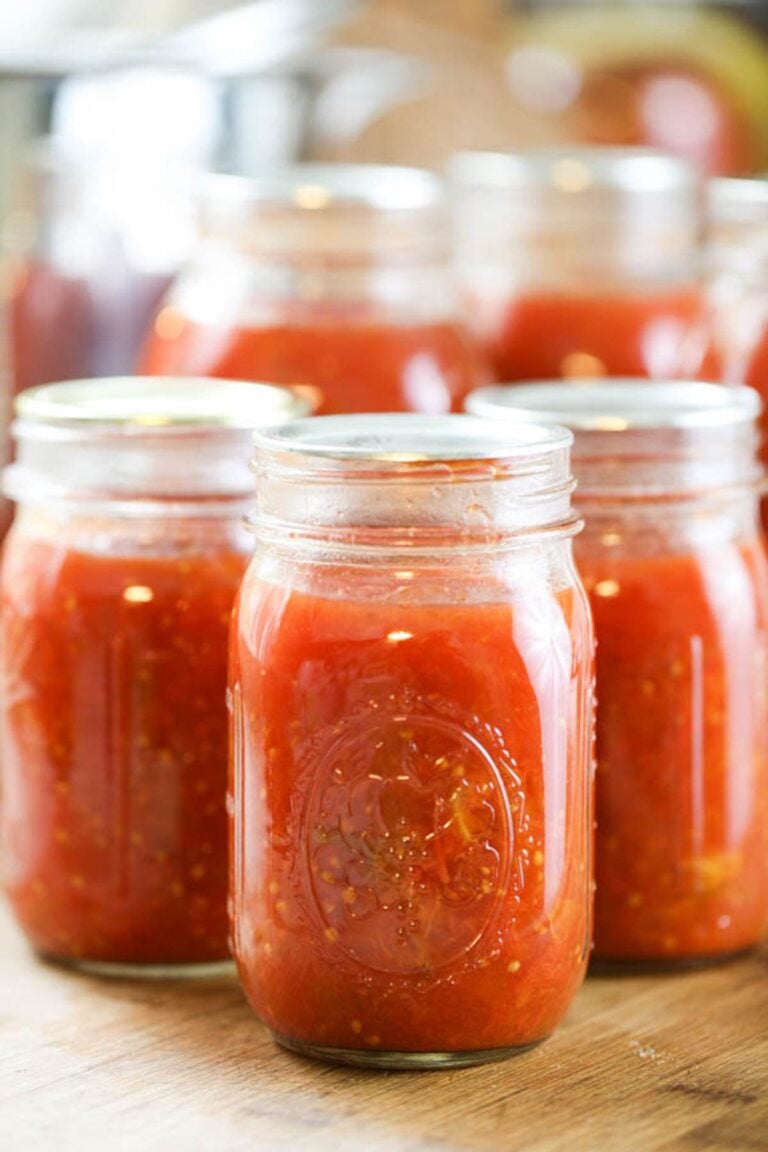
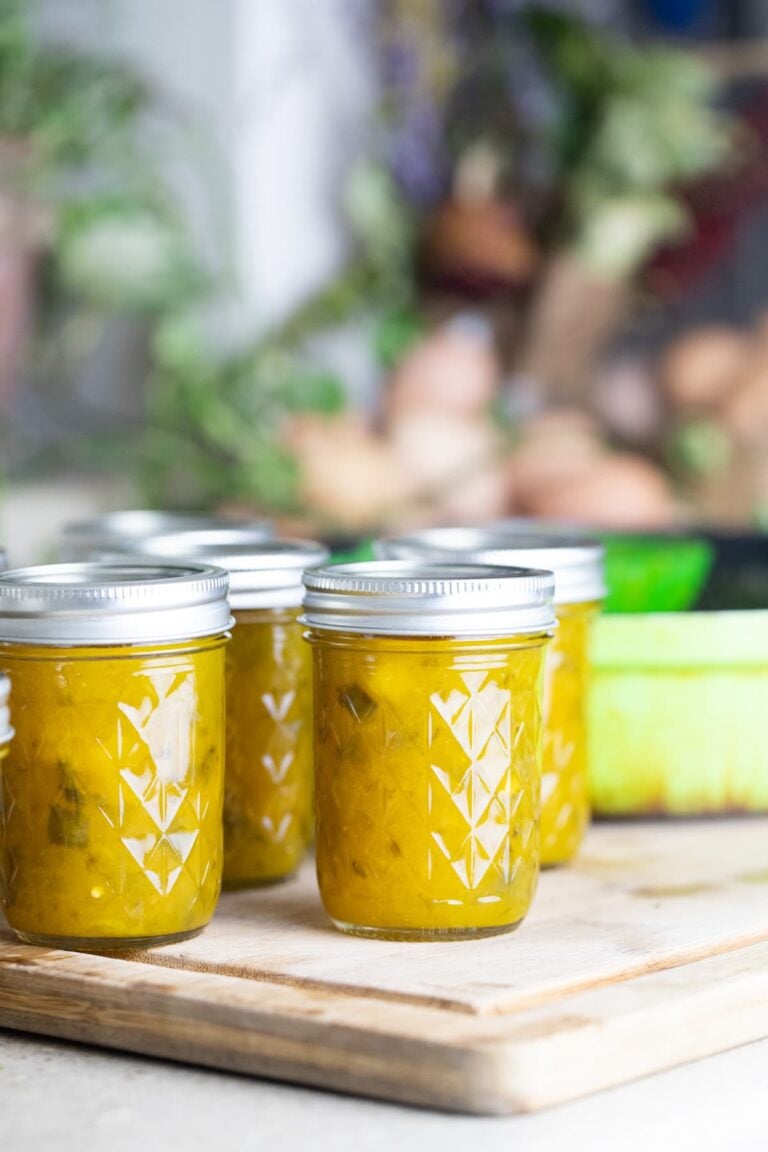
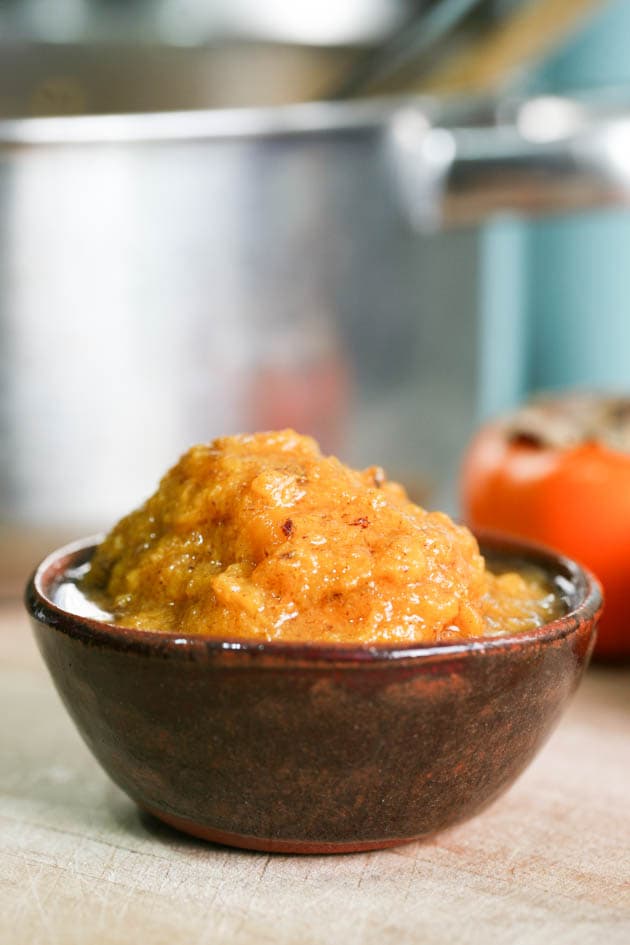
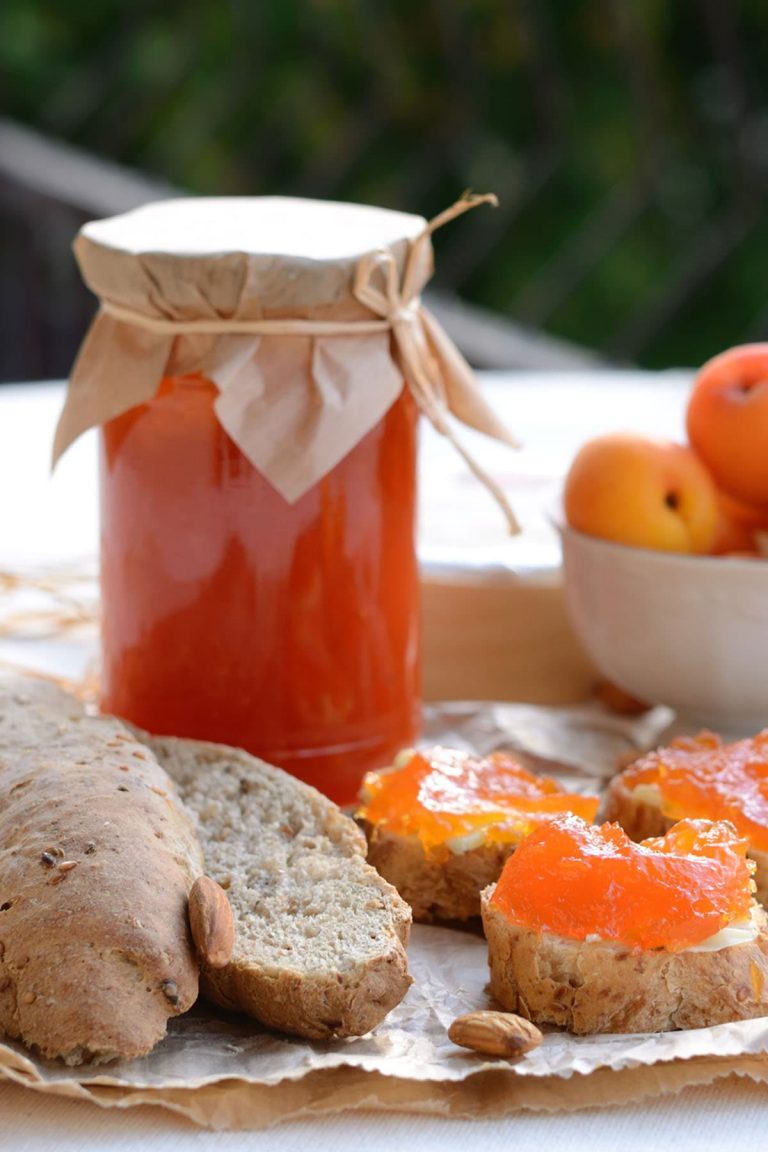
p can I use like sugar substitute my daughter uses monk fruit because she doesn’t use traditional white sugar and will monk fruit work for this to keep it shelf stable in the mongo jam
I’ve never used it… I did use honey in the past and the jam was fine for 4-5 months, but when canning with the intention to keep something on the shelf for a long time, I always use sugar. But you can always store it in the fridge or freeze!
Do you remove the lemon seeds before you fill jars.
I don’t but you can fish them out if they bother you.
Could you use frozen mangoes?
Yes! I’ve made this jam a few times with frozen mangos.